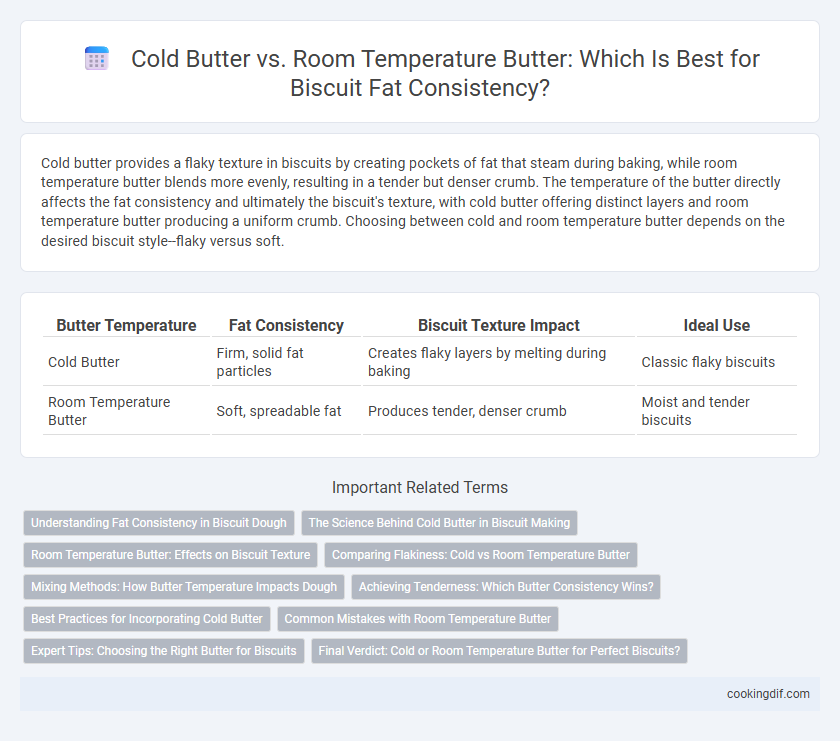Cold butter provides a flaky texture in biscuits by creating pockets of fat that steam during baking, while room temperature butter blends more evenly, resulting in a tender but denser crumb. The temperature of the butter directly affects the fat consistency and ultimately the biscuit's texture, with cold butter offering distinct layers and room temperature butter producing a uniform crumb. Choosing between cold and room temperature butter depends on the desired biscuit style--flaky versus soft.
Table of Comparison
| Butter Temperature | Fat Consistency | Biscuit Texture Impact | Ideal Use |
|---|---|---|---|
| Cold Butter | Firm, solid fat particles | Creates flaky layers by melting during baking | Classic flaky biscuits |
| Room Temperature Butter | Soft, spreadable fat | Produces tender, denser crumb | Moist and tender biscuits |
Understanding Fat Consistency in Biscuit Dough
Cold butter creates a flaky texture in biscuit dough by remaining solid and forming distinct layers during baking, while room temperature butter blends more thoroughly, resulting in a softer and more uniform crumb. Understanding fat consistency is crucial as cold, firm butter produces steam pockets that lift the dough, enhancing flakiness and tenderness. Optimal biscuit dough relies on keeping butter cold to maintain its integrity and achieve the desired light and airy texture.
The Science Behind Cold Butter in Biscuit Making
Cold butter in biscuit making creates steam as it melts during baking, resulting in flakier layers and a tender crumb. The solid fat pieces inhibit gluten formation, producing a lighter, less dense texture. Maintaining butter at low temperatures ensures optimal fat consistency for maximum rise and delicate structure.
Room Temperature Butter: Effects on Biscuit Texture
Room temperature butter blends more evenly into biscuit dough, creating a tender and flaky texture by forming consistent fat layers during baking. This softened fat traps steam efficiently, resulting in biscuits with a light, airy crumb and delicate crumb structure. Using room temperature butter enhances dough pliability, allowing for better gluten development and improved overall biscuit rise.
Comparing Flakiness: Cold vs Room Temperature Butter
Cold butter creates pockets of fat that melt during baking, resulting in a flaky biscuit texture with distinct layers. Room temperature butter blends more thoroughly with the dough, producing a tender but less flaky crumb. For optimal biscuit flakiness, using cold butter maintains a consistent fat structure that promotes lifting and layering during baking.
Mixing Methods: How Butter Temperature Impacts Dough
Cold butter creates a flaky texture in biscuit dough by remaining solid during mixing, allowing small pockets of fat to form and create layers as the dough bakes. Room temperature butter blends more thoroughly with flour, resulting in a softer, more uniform dough with less distinct layers. Choosing cold butter and minimal mixing preserves fat pockets crucial for tender, flaky biscuits, while softened butter yields a denser crumb due to fat fully integrating into the dough.
Achieving Tenderness: Which Butter Consistency Wins?
Cold butter creates steam during baking, forming flaky layers that contribute to a tender, airy biscuit texture. Room temperature butter blends more uniformly with flour, resulting in a denser, softer crumb that emphasizes tenderness over flakiness. For achieving optimal tenderness, using room temperature butter often yields a more uniformly soft biscuit, while cold butter enhances flakiness without compromising overall tenderness.
Best Practices for Incorporating Cold Butter
Cold butter maintains solid fat pockets that create flakier, layered biscuits by steaming during baking. Best practices for incorporating cold butter include cutting it into small cubes and working quickly to blend with flour using a pastry cutter or fingertips while minimizing warmth transfer. Keeping butter cold prevents over-mixing and ensures optimal dough texture for tender, flaky results.
Common Mistakes with Room Temperature Butter
Using room temperature butter in biscuits often leads to over-softening, causing dough to spread excessively and lose its flaky texture. The common mistake of letting butter become too warm results in uneven fat distribution, reducing the biscuit's rise and tenderness. For optimal fat consistency, cold butter ensures small, solid pieces that create pockets of steam, yielding light and flaky biscuits.
Expert Tips: Choosing the Right Butter for Biscuits
Cold butter creates flaky layers in biscuits by producing steam during baking, resulting in a tender, crumbly texture. Room temperature butter blends more evenly with flour, yielding a softer, more uniform crumb and richer flavor. Experts recommend using cold butter for traditional flaky biscuits and room temperature butter for softer, cake-like varieties.
Final Verdict: Cold or Room Temperature Butter for Perfect Biscuits?
Cold butter creates flaky biscuit layers by producing steam pockets during baking, ensuring a tender yet crispy texture. Room temperature butter blends more thoroughly with flour, resulting in a denser, softer crumb. For perfectly flaky biscuits, cold butter is the optimal choice, enhancing fat consistency and producing superior rise and texture.
Cold butter vs Room temperature butter for fat consistency Infographic

 cookingdif.com
cookingdif.com